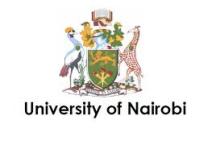Resource information
Effects of land use conversion from forest (F) to annual crop cultivation (AC) and grazing land (LG) on soil qualities were investigated in Sasumua catchment with the aim of (a) determining the changes in selected physical and chemical qualities (b) establishing how various soil [1]quality indicators varied with different land management practices and (c) developing the minimum data set for determination of soil health. Random soil samples were collected from 40 farms (12 under LG and 28 under AC) and 11 forest sites together with 7 water samples from rivers and streams leading to Sasumua Dam. A further 36 core ring soil samples were collected at 0-10 cm depth, from three land uses, 12 from each land use type for analysis of bulk density and hydraulic conductivity. Measurement of CEC, exchangeable Ca, Mg, K and Na, pH, EC, base saturation, total N, soil carbon and texture, bulk density and hydraulic conductivity was done on soil samples while water samples were analysed for quality. Effects of land management practices were determined using structured questionnaire. Data obtained from laboratory was subjected to analysis of variance using Genstat while that from questionnaire was analysed using SPSS. To determine the minimum data set, results obtained were subjected to factor analysis using principal component analysis. The results showed a significant change of soil pH and silt content when land is converted from forest to grazing land and annual crops cultivation. In grazing land ; CEC , exchangeable Ca2+ and Mg2+ , base saturation and SOC decreased by 8%, 42%, 52%, 32% and 8% respectively while Total N increased by 6 % . In annual crop cultivated land; exchangeable Ca2+ and Mg2+ , base saturation and SOC decreased by 31%, 40%, 32% and 8% respectively, while CEC, Total N, and bulk density increased by 14%, 23% and 10% ,respectively. Land management practices such as intensive cultivation of horticultural crops, overgrazing of pastureland and farming on steep areas were contributing to soil chemical and physical degradation while addition of farmyard manure and agro-forestry were contributing to sustainability of soil organic carbon and bulk density. Tillage in cultivated fields influenced increase in CEC. Water quality results indicated that land use management affected quality as it flows from forest to areas with human settlements. Soil pH, texture, SOC and CEC were found to be the minimum data set for determination of soil health in the catchment as they cumulatively accounted for 83% of the variation in component loadings.


